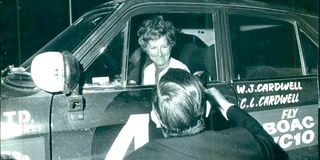All-woman crews starting lighting up Safari Rally from the 1950s

The 1974 Safari Rally was monumental for women competitors.
What you need to know:
- Mary Wright and Juanita Burton, also driving a Ford Zephyr, finished fifth overall and winners of the First Ladies Prize in the 1955 edition.
- Another female crew of Mary Heather Hayes co-driven by Lucille Cardwell finished seventh aboard a VW Beetle in Class A of cars priced at £600 or less.
- Thus the tradition of women also thriving in the toughest rally in the world was established.
As Vic Preston Senior and D.P. Marwaha won the 1954 Coronation Safari Rally in a nimble VW Beetle, then retained the title in a Ford Zephyr, an all-woman crew was also making a name.
Mary Wright and Juanita Burton, also driving a Ford Zephyr, finished fifth overall and winners of the First Ladies Prize in the 1955 edition.
Another female crew of Mary Heather Hayes co-driven by Lucille Cardwell finished seventh aboard a VW Beetle in Class A of cars priced at £600 or less.
Thus the tradition of women also thriving in the toughest rally in the world was established.
The 1974 Safari Rally was monumental for women competitors who captured the imagination of Kenyans. That edition saw the entry of three all-female crews and one that had a woman co-driver.
These were Mary Ondieki/Pamela Onyango, Rosemary Smith/Pauline Gullick, Ann Teith/Sylvia King and Pauru Choda who navigated her husband Prem Choda to 15th overall position aboard a Mitsubishi Galant.
Smith and Gullick finished 16th in a Datsun 1800SSS.
The crew of Teith, navigated by King finished 18th in 1972 and went on to mature into the most successful ladies team in the history of the Safari.
The duo won the Kenya national title in 1984, followed by Pauru whose record of most attempts and seven finishes saw her become part of the Safari folklore until her retirement in 1990.
Alive and in good health, Pauru remains a good example of why affirmative action never made any impression in the Safari, but that is a story for another day.
This year, Fabrizia Pons of Italy, third in 1983, co-driving the great Frenchwoman Michelle Mouton in an Audi Quattro, will navigate veteran Kenyan driver Kenyan Piero Cannobio.
Preston and Marwaha did not win without incidents including one particular “head on” with a vulture which saw the avian slam onto the windscreen, shattering it before collapsing in the back seat, but alive.
Marwaha was forced to get his eyes off the road momentarily to free the bird and return it to the wild to avoid distractions in the car cabin.
Such incidents became part of the folklore of the Safari.
A second such encounter between a rally car and a bird happened right in front of global TV cameras in 2001.
A bird in full flight hit the top left of Tommi Makinen’s Mitsubishi Lancer just above his head, showering him with broken glass but his face was saved by the crash helmet. “It was very difficult after that,” recalls Makinen, who nevertheless, went on to win his second Safari Rally navigated by Risto Mannisenmaki.
The 1955 Safari was divided into classes and organisers were happy to register an impressive 19 finishers from 56 starters. This was a higher number than 51 recorded the previous year.
Preston’s victory heralded a new era of the Safari Rally. The VW Beetles had dominated the first two editions, and recorded total domination in the Class A.





